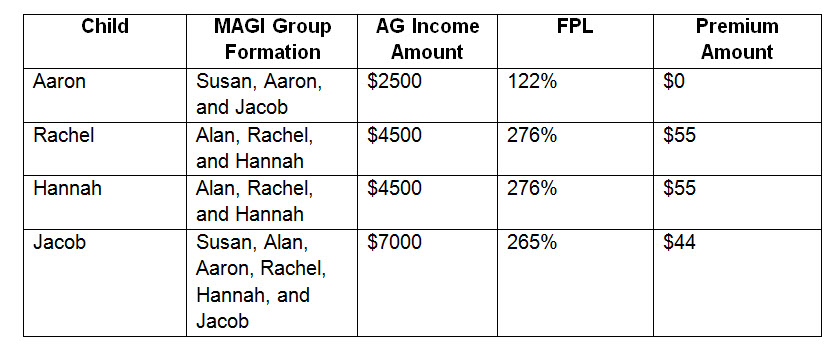19.3 Premium Limits
For all BadgerCare Plus members whose eligibility is determined under non-MAGI rules, families with incomes at or below 300% of the FPL will never have to pay in excess of 5% of the family income for their total premiums.
The 5% caps will be calculated for income ranges of 10% of the FPL. For example, the 5% cap would be the same for a family with income at 211% of the FPL as it would be for a family with an income at 218% of the FPL.
Exceptions to this policy are:
-
Children living with caretaker relatives exception: Unlike children living with their parents, eligibility for children living with caretaker relatives is determined separately from their caretaker relatives and from other children living with the caretaker relative. The amount of their premium is based solely on their income. The 5% cap on the child living with a caretaker relative premium is calculated separately from the caps on the premiums for other children living with caretaker relative in the household and from the cap on the premium for the caretaker relative and the caretaker relative’s immediate family.
-
Exception for children and self-employed parents with incomes over 300% of the FPL: Usually the 5% premium owed for self-employed parents will not exceed the amount of the per member per month (PMPM) cost of the children’s premiums. However, some larger families with more than five children will have PMPM costs greater than 5% of the family’s income. For those families, collect the full PMPM per cost for those children even though it exceeds the 5% limit. For those families, no additional premium amount will be owed for the self-employed parents.
-
Adults with incomes over 180% of the FPL in a BadgerCare Plus Extension.
-
Adults with incomes over 180% of the FPL up to 200% of the FPL.
For all BadgerCare Plus members whose eligibility is determined under MAGI rules, children with assistance group income above 201.00% of the FPL will be required to pay premiums. The total premium amount for the household is the total of the individually calculated premiums, not to exceed a 5% cap. The cap will be 5% of the income of the assistance group with the highest income (in terms of dollar amount) in the case.)
The 5% cap methodology for children with premiums will be effective as soon as one child on the case who is subject to premiums has his or her eligibility determined using MAGI rules.
Example: Susan and Alan are non-marital co-parents caring for four children: Susan’s son, Aaron (15); Alan’s daughters Rachel (12) and Hannah (11); and Susan and Alan’s son Jacob (9). Alan claims Rachel and Hannah as his two tax dependents, while Susan claims Aaron and Jacob. Susan earns $2500/month as a waitress, and Alan earns $4500/month as a computer analyst. None of the children have income. All four children are eligible for BadgerCare Plus.
 Aaron does not have a premium, Rachel and Hannah have $55 premiums, and Jacob has a premium of $44. In this example, 5% of the income of the assistance group with the highest income is 5% of Jacob’s MAGI group, or 5% of $7000/month, or $350. Altogether, the household’s monthly premiums are $154. The household will pay $154 in premiums for their children’s coverage.
Aaron does not have a premium, Rachel and Hannah have $55 premiums, and Jacob has a premium of $44. In this example, 5% of the income of the assistance group with the highest income is 5% of Jacob’s MAGI group, or 5% of $7000/month, or $350. Altogether, the household’s monthly premiums are $154. The household will pay $154 in premiums for their children’s coverage. |
Parents and caretakers in Extensions will pay premiums based on the sliding scale discussed above, without a 5% cap applied. Non-exempt children with incomes above 201% of the FPL will not be required to pay premiums when the adults in the household are paying premiums in an Extension. If the parents enter a restrictive re-enrollment period (RRP) for failure to pay a premium or are otherwise ineligible, non-exempt children with income above 201% will be required to pay a premium.
This page last updated in Release Number: 14-01
Release Date: 02/07/14
Effective Date: 02/01/14